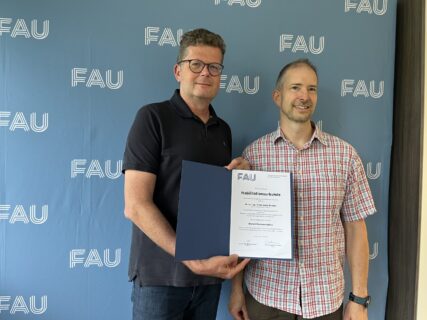Successful habilitation: Dr. rer. nat. habil. Frank Wendler

Dr. Frank Wendler from the Chair of Materials Simulation (WW8) has successfully completed his habilitation. The future Dean of the Faculty of Engineering, Prof. Dr. Marc Stamminger, congratulated him on receiving his habilitation certificate.
Mr. Wendler revealed his motivation for his habilitation and his plans for the future in a short interview. He is expected to present his research to the public at the WW Sommerfest 2026.
Topic of Habilitation thesis
“Modeling and Simulation of Thermomechanically Coupled Loading Problems for Shape Memory Alloy Devices”
What was your motivation to habilitate?
The main reason for me was clearly the resulting independence in academic research and teaching, i.e. the opportunity to offer my own lecture topics or supervise students. Even if this does not result in an immediate expansion of my skills in my day-to-day work, it makes it much easier for me to supervise final theses and doctoral dissertations, and of course gives me a certain confirmation of what I have achieved.
Finding the necessary time and a common thread for the habilitation thesis was not easy in my case. Due to the very different fields of research in the area of simulation of functional materials, I limited myself in the habilitation thesis to a sub-area of my work, the constitutive modeling of shape memory alloys (SMA). In my work – which of course also reflects the achievements of my doctoral students during the habilitation phase – I show how SMA models can be extended for dynamic load situations in damping applications and enable the calculation of the performance of micro-origami materials and dental implants. The different fields of application always required a new perspective on the problem; and I am very grateful to the expert mentors, in particular Prof. Michael Zaiser, for their support during this often difficult phase.
What are your plans for the future?
I am fortunate to be able to continue working at FAU, although I am of course already looking outside the box. I will be more involved in two areas in the future: Firstly, with colleagues from medicine in the simulation of biomechanical issues, in particular the use of functional materials such as SMA in dental implants, including fatigue and improved models for interaction with bone. I am also interested in how pattern formation processes from classical materials science such as spinodal segregation, de-alloying and eutectic decomposition can be controlled for the targeted optimization of microstructures for catalysis, electrode and filter applications. By combining kinetic structure simulations and machine learning methods, we want to investigate how the material structures itself at the micro level. The potential for energetically sustainable methods is far from exhausted here.
On the other hand, I will of course continue to work on modeling lead-free ferroelectrics as part of the GRK 2495 graduate school. The connection with colleagues from the many sub-projects here at FAU and at NITech in Japan is a real enrichment for my research work. We are generally working here on a combination of atomistic and continuum simulations for domain evolution, currently, among other things, on improving our free simulation code so that “non-simulants” can also be simulated.